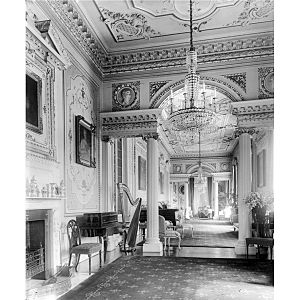Gilling Castle facts for kids
Gilling Castle is an amazing old castle located near Gilling East in North Yorkshire, England. It's considered a very important historical building, known as a Grade I listed castle.
Contents
The Castle's Story
The castle's history began with the Etton family. They lived here around the late 1100s.
Early Days and First Builders
In the 1300s, a man named Thomas de Etton built a strong house. It was a large, nearly square tower. The bottom part of this tower is still the main part of the castle you see today.
Later, in 1349, the Etton family made a plan. If they didn't have a male heir, the castle would go to the Fairfax family. This happened in 1489, and Thomas Fairfax took over.
Sir William Fairfax's Changes
His great-grandson, Sir William Fairfax, became the owner in 1571. He decided to rebuild the old 14th-century house. He kept the ground floor walls. Then, he added new first and second floors on top.
Sir William also added a staircase tower at the back. He included a special bay window, called an oriel window. The famous Great Chamber was also built during this time.
Fairfax Family and New Designs
In the early 1700s, the owner was Viscount Fairfax of Emley. He updated many parts inside the castle. He also added wings that created a front courtyard.
People often thought famous architects like John Vanbrugh or James Gibbs designed these changes. However, it seems a local architect named William Wakefield did the work. Later, in the 1750s, John Carr made some small changes. He was also working on another Fairfax home in York.
New Owners and Restoration
The Fairfax family line ended in 1885. The castle then changed hands a few times. In 1929, Ampleforth Abbey bought Gilling Castle.
However, the beautiful wooden panels and glass from the Great Chamber were sold separately. Luckily, with help from the Pilgrim Trust and many friends, these pieces were bought back. They were put back into the Great Chamber in 1952.
Until 2018, Gilling Castle was home to St Martin's Ampleforth. This was a prep school for Ampleforth College.
The Great Chamber: A Special Room
The Great Chamber is the most important room in the castle. Sir William Fairfax, who owned Gilling from 1571 to 1597, rebuilt it. This room is special because it stayed almost the same during the 1700s updates. It's a fantastic example of a rich and detailed room from the late Elizabethan period.
Family Symbols and Art
Sir William loved to show off his family connections. He used family symbols, called heraldry, to decorate the room. There was so much heraldry that visitors in the 1590s could use a book to identify the symbols! These symbols were in plaster, paint, and glass. A Flemish artist signed the glass, adding the date 1585. This means the room was finished that year.
Woodwork and Inlays
The room has wooden panels, called wainscoting, made of English oak. These panels are divided into three large sections in each corner. Diamond shapes within the panels are filled with cool patterns. These patterns are made from dark ebony and light holly wood. Each pattern is different, and there are almost a hundred around the room! Each small triangle panel has a flower inlaid into it.
Fireplace and Frieze
The fireplace has the Fairfax family's main symbol in the middle. Above it are the symbols of Queen Elizabeth I. The wall above the fireplace also shows the symbols of Sir William's four sisters and their husbands.
Above the wooden panels, there's a long painted strip called a frieze. It shows the symbols of important gentlemen from Yorkshire. These symbols are grouped by twenty-one Wapentakes. A Wapentake was an old way to divide a county. Each Wapentake has a tree, and the symbols of gentlemen from that area hang on its branches.
Amazing Stained Glass
Sir William's best heraldic art is in the painted glass windows. The south window is almost complete. It shows the family history and symbols of his second wife's family, the Stapletons.
The bay window has some damage. Its bottom row of glass was replaced with clear glass, probably in the 1700s. This window tells the story of the Fairfax family. Both of these windows were made by Bernard Dininckoff. He even left his signature, the date 1585, and a tiny picture of himself in the south window!
The third window, on the east side, also lost its lower glass. It was made by a different artist a bit later. This window shows the story of the Constable family. This is because Sir William's only son, Thomas, married Catharine Constable of Burton Constable.
Ceiling Details
The room's look was completed by its ribbed plaster ceiling. It has cool fan shapes and hanging decorations. Sir William's love for heraldry is here too. The spaces between the ribs are decorated with lions, which are the Fairfax family symbol. There are also goats and talbots, which are symbols of the Fairfax and Stapleton families.
See also
 In Spanish: Castillo de Gilling para niños
In Spanish: Castillo de Gilling para niños



